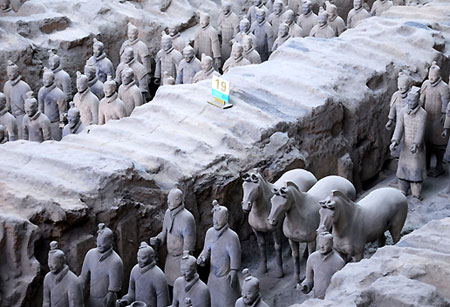 |
|
File photo shows ancient terra-cotta warriors in No. 1 pit of Qinshihuang mausoleum in Xi'an, northwest China's Shaanxi province. [CFP] |
Archaeologists will begin a third phase of excavation at the famous terracotta army site on Saturday, hoping to find more clay figures and unravel some of the mysteries left behind by the "First Emperor".
The excavation work will focus on a 200-sq m patch in the north-central part of the No 1 pit, the largest among three pits at the site.
Archaeologists hoped to find more clay figures of high-ranking officers, Liu Zhancheng, head of the archeological team under the terracotta museum in Xi'an, capital of Shaanxi province, was quoted by Xinhua News Agency as saying yesterday.
Such high-ranking army officers are rare. The majority of the terracotta are archers, infantrymen and charioteers that the emperor hoped would help him rule in the afterlife.
The museum website said less than 10 such "armored generals" have been unearthed.
Liu also said the excavation will test preservation technology that the museum has spent decades developing to keep the undiscovered terracotta figures intact and retain their original colors.
In past excavations, richly colored clay figures were unearthed from the mausoleum of Qinshihuang (259-210BC), the first emperor of a united China, but once they were exposed to the air they began to lose their luster and turned an oxidized grey.
A museum archaeologist, who insisted on anonymity, said the museum has been cooperating with a cultural relic department in Germany for years trying to find a satisfactory technology to preserve the color of the terracotta, and has "made some headway."
But he also noted that people should not put too much hope on seeing vividly colored terracotta from the upcoming excavation because "the No 1 pit was the most severely damaged among the three pits by a large fire".
The cause of the fire, which began long before excavations took place, remains a mystery, he said.
Museum sources, however, declined to reveal the reason why they planned to excavate the 200-sq m patch, which is not linked to the already unearthed part.
The State Administration of Cultural Heritage has approved the museum's plan for the third excavation, and the excavation is likely to continue if it proves fruitful.
Wu Yongqi, curator of the museum, said that the 230-m by 62-m pit is believed to contain about 6,000 life-sized terracotta figures, more than 1,000 of which have been found in previous excavations.
The upcoming excavation will last at least a year, he said.
The army of terracotta warriors and horses was one of the greatest archeological finds of modern times. It was discovered in Lintong county, 35 km east of Xi'an, in 1974 by peasants digging a well.
The first formal excavation of the site lasted from 1978 to 1984 and uncovered 1,087 clay figures. A second excavation, in 1985, lasted a year and was cut short for technical reasons.
The discovery, listed as a World Heritage Site by UNESCO in December 1987, has turned Xi'an into one of China's major tourist attractions. Many state leaders have traveled to the site during visits to China.
(China Daily June 11, 2009)